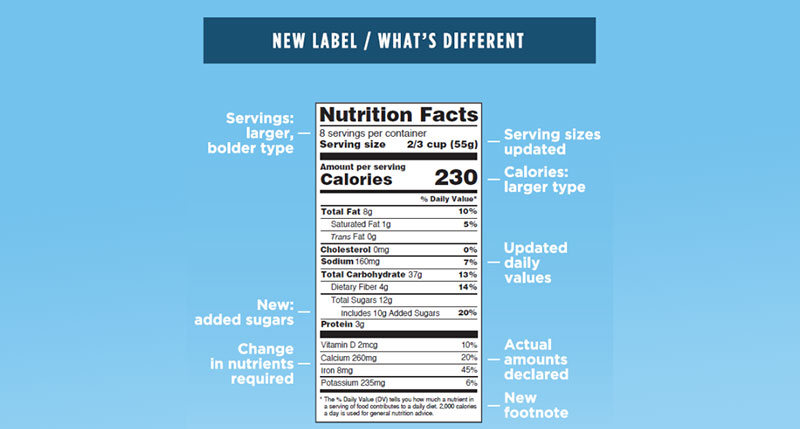Do you read ingredient labels on packaged foods? They can feel confusing or misleading. Maybe you’re not sure what to look for or what’s important. Should you be counting calories? Watching fat intake? Tallying carbs?
It’s enough to make you forget the whole thing and curl up with a pint of Ben & Jerry’s.
Fortunately, confusing nutritional labels don’t have to be a challenge. It’s simply a matter of knowing what to look for.
Looking at Labels
If you’ve never looked closely at a nutritional label before, you’ll notice a lot of information packed into that tiny rectangle. The good news is that most ingredient labels follow the same pattern, so once you get the hang of it, you’ll be set.
Here are the main components of a standard ingredient label to consider.
Serving size
This section of the label is important because it tells you what amount the manufacturers consider to be “one serving.” Often, their serving size and your serving size may not be the same. For example, if there are supposed to be four servings in a package, and you’re going to eat the whole package in one sitting, you’ll need to multiply every number on that nutritional label by four. Otherwise, you’ll be looking at data for one-fourth of the volume you actually consumed.
Calories
Calories are simply a way of measuring the amount of energy a particular food delivers to your body. The higher the calories or more “calorie-dense” a food is, the more energy it provides.
The key is simply to balance intake and output. Presuming you’re maintaining your weight, you’ll want to be eating roughly the same number of calories you expend each day. If weight loss is your goal, you’ll want to consume fewer calories than you burn each day, forcing your body to burn its fat reserves for extra energy.
Fat
Fat has gotten a bad rap over the years. Many of us think it’s causing us to be ― well, fat! Blaming obesity challenges on the fat content of your food is not only unfair; it’s also incorrect. Not only do many other factors influence weight gain, including total calorie consumption and quality of calories consumed, but our bodies process different types of fat differently (monounsaturated fats and trans fats are not created equal!). Specific fats ― the monounsaturated kind found in olive oil and avocados ― are essential for cell function and overall health. Other types of fats ― hydrogenated and trans fats, largely found in heavily processed foods ― cause countless health complications, especially when eaten in excess.
Carbohydrates and Fiber
Carbohydrates, like fat, are a source of fuel for our bodies. Sugars are a form of carbohydrate. Fiber, the indigestible “bulk” that passes through our digestive systems, collecting waste for elimination, is like an “anti-carb” that helps slow down the digestion of sugars and carbs. In general, the more fiber a food has, the greater its ability to slow the absorption of carbs, thereby reducing blood sugar spikes.
Generally, higher-fiber foods are healthier and less processed than their low-fiber counterparts ― think whole grain bread vs. white bread, an apple vs. apple juice, or steel cut oats vs. quick-cook.
Sugars
Sugars are carbs ― the most addictive kind. So addictive, in fact, there is no recommended daily amount of sugars; less is always better. That said, some kinds of sugars are worse for us than others. Naturally occurring sugars, such as in fruits, are far easier on the body than heavily processed sweeteners like high-fructose corn syrup.
Because it’s so addictive, food manufacturers pack sugar into just about every processed food out there. There are countless names for sugar, and food manufacturers are quite good at making sugar sound like not-sugar. But the nutritional label doesn’t lie; the total number of sugars is listed for all to see. So, investigate how many sugars are in the foods you’re buying. Are there lots of sugars? If so, check the ingredient list. Where is that sugar coming from? How much are you consuming over the course of a day? Can you swap out some processed foods full of unhealthy sugars for healthier whole food options like fresh fruits?
Protein
Often overlooked by all but bodybuilders and fitness fans, protein is another essential building block found in our food. It’s necessary for creating strong and powerful muscles, breaking down toxins, and moving molecules around the body. However, most American diets are already extremely protein-heavy. Unless you’re underweight or specifically looking to build muscle, you probably don’t need to add any more meat to your diet (and may even benefit from vegetarian meals a couple of days a week!).
Percent Daily Value (% DV)
You’re probably not an exact match for the FDA’s profile of the standard citizen. But that doesn’t mean the Percent Daily Value (%DV) numbers, listed down the right-hand side of the nutrition label, aren’t helpful. Even if you don’t require exactly 2,000 calories a day, reading a label and discovering, for example, that a single frozen dinner will deliver 1,300% of your daily recommended sodium intake should raise a red flag.
Whether you’re aiming for weight loss, gaining muscle, eating more healthfully, or fueling your body and mind, nutritional labels are an excellent tool to help you on your way. With a little practice and patience, you’ll be able to tap into the information available on every label, ensuring your meals match your mission. In no time, you’ll be a label-reading master, using the information at your fingertips to propel you straight toward achieving your health goals.

